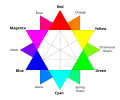
Midnight blue is a dark shade of blue named for its resemblance to the apparently blue color of a moonlit night sky around a full moon. Midnight blue is identifiably blue to the eye in sunlight or full-spectrum light, but can appear black under certain more limited spectra sometimes found in artificial lighting (especially early 20th-century incandescent). It is similar to navy, which is also a dark blue.
